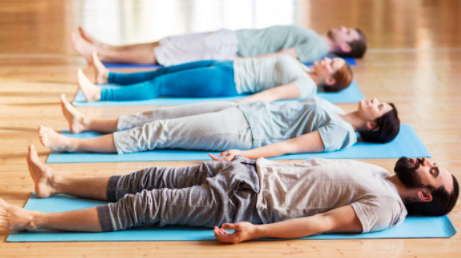Yoga Nidra
Rest as a Practice of Recovery
Yoga Nidra, sometimes translated as ‘yogic sleep’, is a structured form of guided rest. Practised lying down or in a reclined position, it invites the body to settle while the mind follows gentle verbal prompts into a state between waking and sleep. Unlike traditional meditation techniques that require focused attention, Yoga Nidra works by drawing awareness inward progressively relaxing the body, quietening mental activity, and allowing the nervous system to shift into repair mode.
Over recent years, Yoga Nidra has received increasing attention in both wellness and clinical settings. Research suggests it can play a valuable role in reducing stress, improving sleep, enhancing mood, and supporting emotional regulation. For people living with the effects of trauma, chronic stress, or neurological conditions, it offers an accessible and adaptable form of practice that doesn’t rely on movement, cognitive effort, or advanced meditation experience.
What Happens During Yoga Nidra?
Most Yoga Nidra sessions begin with a short orientation, followed by breath awareness, a guided body scan, and sometimes a simple visualisation. The practice often includes setting a personal intention (Sankalpa), which is repeated silently at the beginning and end of the session. Throughout, the aim is to maintain a thread of awareness while allowing the body and mind to rest deeply. Sessions can range from 10 to 40 minutes and are commonly guided by an instructor or audio recording.
Studies using brain imaging and physiological monitoring have shown that Yoga Nidra activates the parasympathetic nervous system the branch responsible for rest and repair. It lowers arousal, reduces heart rate and skin conductance, and modulates stress hormones such as cortisol. EEG research indicates increased alpha and theta brain wave activity during practice, patterns associated with deep relaxation, creativity, and internal focus. These shifts may explain why even short daily sessions have been found to improve mood, reduce anxiety, and support sleep.
Psychologically, Yoga Nidra appears to support emotional regulation by fostering detachment from distressing thoughts and emotions. By helping individuals observe internal experiences with calm awareness, it strengthens skills aligned with mindfulness and cognitive flexibility. The inclusion of intention-setting echoes aspects of cognitive-behavioural approaches, where affirmations or personal commitments are used to reinforce positive change.
Supporting Cognitive Health and Function
Beyond its calming effects, Yoga Nidra has shown promise in enhancing cognitive performance. Several studies report improvements in memory, attention, and reaction time following regular practice. These benefits may stem from multiple factors: reduced stress interference, improved sleep quality, and enhanced neuroplasticity. The deep rest induced by Yoga Nidra also supports the consolidation of learning and restoration of executive functioning, important for anyone living with cognitive load, burnout, or recovery from illness.
Adapting Yoga Nidra for Brain Injury
While most research to date has focused on general mental health and wellbeing, there is emerging evidence that Yoga Nidra may be a useful complementary therapy for people with brain injury. One small study involving individuals with cognitive impairment found improvements in memory, mood, and stress levels following a regular Yoga Nidra routine. Another feasibility study involving adults with chronic traumatic brain injury showed high engagement with a group-based programme that included Yoga Nidra elements, with participants reporting better sleep, lower depression, and improved cognitive function.
These findings are early but encouraging. In many rehabilitation contexts, fatigue, sensory overload, and reduced working memory can make traditional meditation or group therapies difficult to access. Yoga Nidra’s non-demanding, internally guided structure may be particularly well-suited to people with cognitive or neurological challenges.
A Practice for Everyone
Yoga Nidra requires no experience, no special equipment, and no expectation of achievement. It meets you where you are whether seeking rest, healing, or a way to unwind at the end of a long day. It can be used as a stand-alone wellbeing practice or integrated into therapy, recovery, or rehabilitation pathways.
While the evidence base continues to grow, what is already clear is that this quiet practice holds powerful potential. For some, it becomes a gateway to deeper emotional awareness. For others, it simply offers permission to stop and rest. Either way, the benefits are cumulative and often surprisingly profound.
Always consult a healthcare provider or neurorehabilitation specialist before introducing new practices post-injury. For those ready to try, even a few minutes can begin to rebuild the bridge between mind and body, rest and recovery.
Audio recordings of both a standard and an adapted Yoga Nidra practice along with other guided meditations and recordings are available on this page.



